Crafting pom-poms is a delightful and creative endeavor, but ensuring they don’t unravel or fall apart is crucial for a polished and durable finish.
“How to Make Pom-Poms That Don’t Fall Apart” is a guide designed to impart essential techniques for crafting sturdy and long-lasting pom-poms.
This guide provides step-by-step instructions, from selecting the right materials to mastering the wrapping and tying process.
Learn the art of securing your pom-poms precisely, ensuring they withstand handling and maintain their charming fluffiness over time.
Perfect for various crafts and DIY projects, this guide ensures your pom-poms remain intact and visually appealing throughout their use.
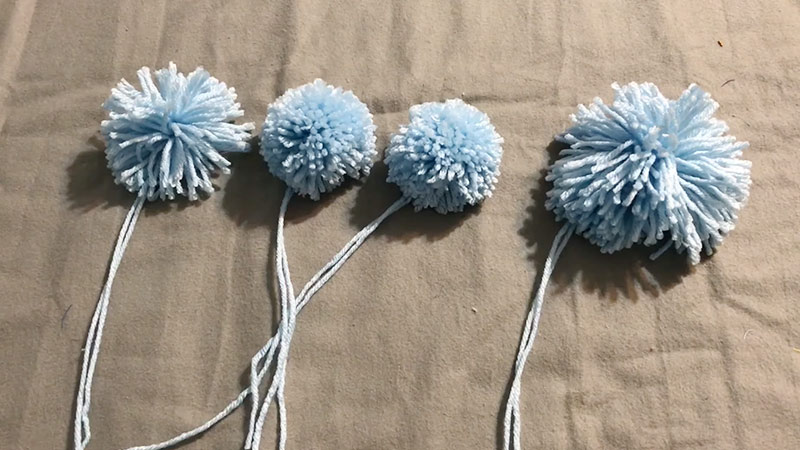
What Is Pom Pom?
A pom-pom is a decorative ball made of yarn or fabric, often used to embellish clothing, accessories, or crafts.
It is created by winding materials around a central core, forming a round, fluffy sphere. Pom-poms add a playful and vibrant touch to various items, from hats and scarves to home decor.
They come in various sizes and colors, offering a versatile and whimsical element in creative projects.
Beyond aesthetics, pom-poms are also popular in cheering squads and sports events, where they are attached to the ends of sticks or used as accessories to enhance team spirit.
How Do You Make Poms That Don’t Fall Apart?
Making pom-poms that don’t fall apart requires attention to detail and proper techniques.
Whether you’re creating pom-poms for crafts, decorations, or even clothing accessories, here’s a step-by-step guide on how to make a pom that doesn’t fall apart:
Materials Needed:
- Yarn in your desired color
- Cardboard or a pom-pom maker
- Scissors
- Sharp needle or small crochet hook
- Strong thread
Step-by-Step Instructions:
1. Choose the Right Yarn
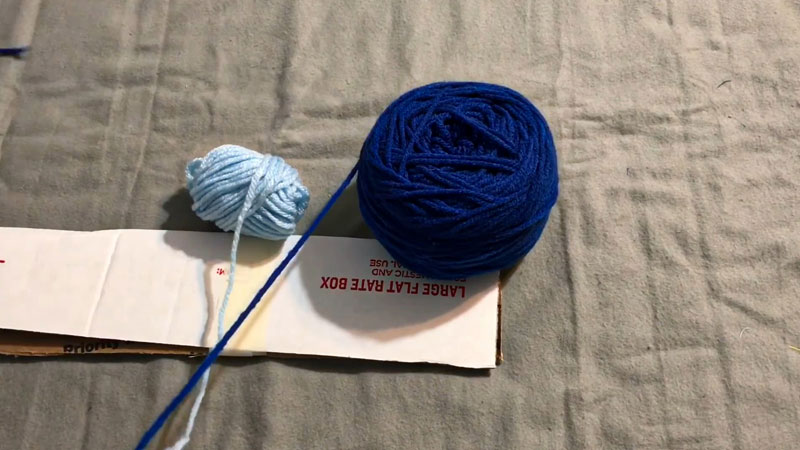
Selecting the appropriate yarn is crucial for the durability and longevity of your pom-poms.
Opt for yarn with a strong fiber structure and good tension; these qualities will help the pom-pom maintain its shape over time.
Avoid using slippery or delicate yarns that may unravel easily, as they can lead to a less secure final product.
2. Prepare Your Tools
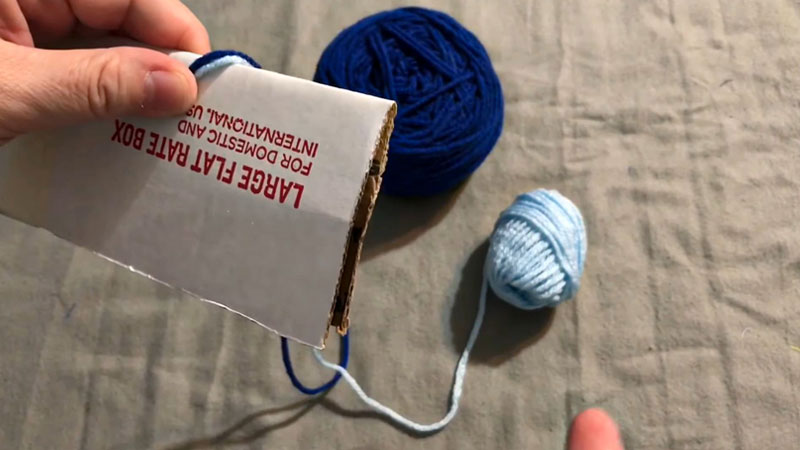
Choose between cardboard or a pom-pom maker, depending on your preference and availability.
If opting for cardboard, cut out two identical donut shapes. Ensure they are sturdy and of the desired size for your pom-pom.
If using a pom-pom maker, take the time to familiarize yourself with the specific instructions provided with the tool. Understanding the tool’s nuances will contribute to a smoother pom-pom-making process.
3. Wrap the Yarn
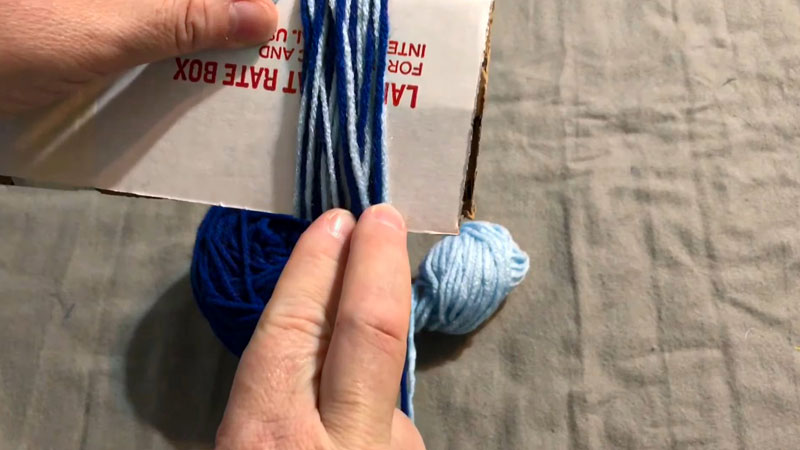
For cardboard: Align the two donut shapes together and wrap the yarn around them. The more yarn you wrap, the denser and fuller your pom-pom will become. Make sure to distribute the wraps evenly to achieve a balanced result.
For a pom-pom maker: Follow the step-by-step instructions included with the tool. Typically, this involves wrapping yarn around both sides of the pom-pom maker.
Ensure consistent tension throughout the wrapping process to ensure a uniform pom-pom.
4. Secure the Yarn
For cardboard: Once you have wrapped enough yarn, delicately insert a piece of yarn between the two cardboard layers.
Tie a tight knot around the entire bundle, ensuring it is secure. This central knot is essential for holding the pom-pom together.
For a pom-pom maker: Follow the instructions to close the maker securely. This step is crucial to maintaining the tension in the yarn and preventing the pom-pom from unraveling. Ensure that the closure is tight and secure.
5. Cut the Yarn
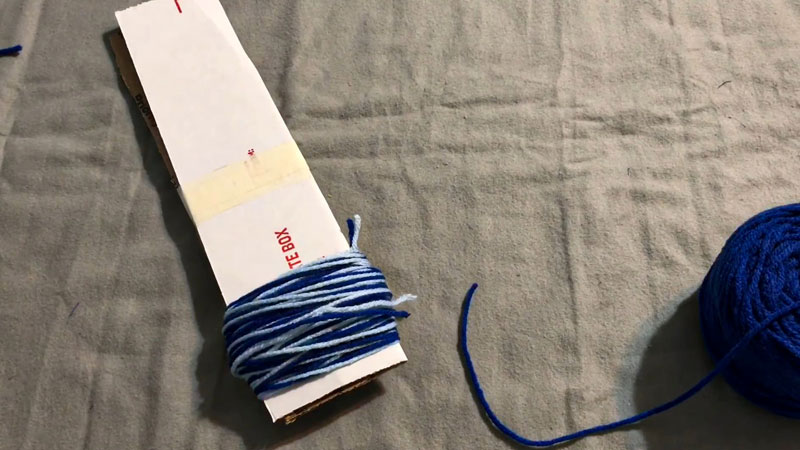
For cardboard: After securing the yarn with a knot, carefully slide your scissors between the two cardboard layers.
Cut through all the loops around the edge, releasing the yarn strands. Take your time to avoid accidentally cutting any securing knots.
For a pom-pom maker: Utilize the designated groove or follow the marked lines on the maker to cut through the loops. This step will free the pom-pom from the maker, revealing the fluffy, untrimmed form.
6. Shape the Pom-Pom
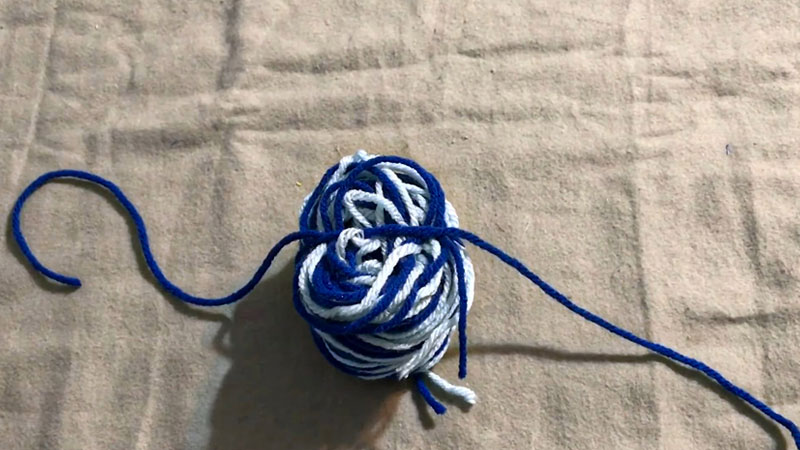
After releasing the pom-pom from its form, gently fluff it out to achieve its full, fluffy appearance.
Mold the pom-pom into a round shape, adjusting the strands as needed to create a uniform and appealing form.
Use your fingers to shape and reshape until you are satisfied with the overall look. Trim any uneven strands with scissors, paying attention to achieve a balanced and well-rounded result.
7. Secure the Pom-Pom
To ensure the longevity of your pom-pom, tying a secure knot is crucial. If you used cardboard, tie a tight knot in the center of the pom-pom using the same yarn that was used for wrapping. This central knot is the anchor for the pom-pom, holding it together.
If you used a pom-pom maker, carefully remove the pom-pom from the maker and tie a secure knot in the center.
Take care during this step to avoid accidentally pulling apart the strands or distorting the shape of the pom-pom.
8. Reinforce the Knot
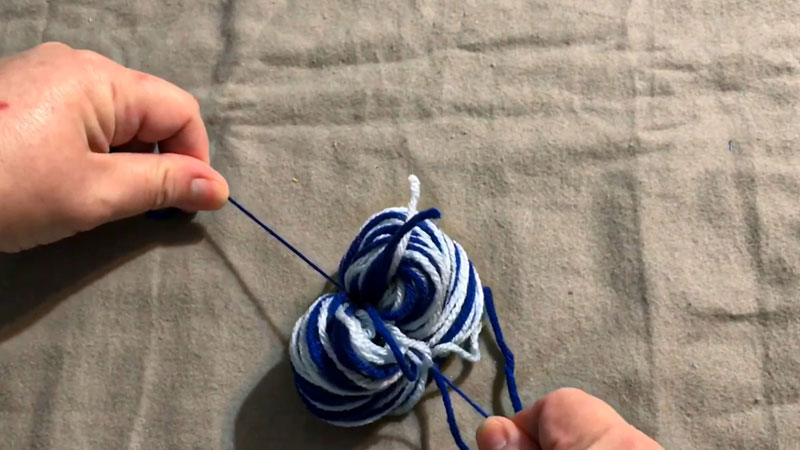
For added durability, reinforce the central knot. Thread a sharp needle or a small crochet hook with a length of strong thread.
Pass the needle or hook through the center knot and out the other side. Pull tightly to secure the knot further.
This extra reinforcement ensures that the pom-pom remains tightly bound and reduces the risk of unraveling.
9. Trim Excess Yarn
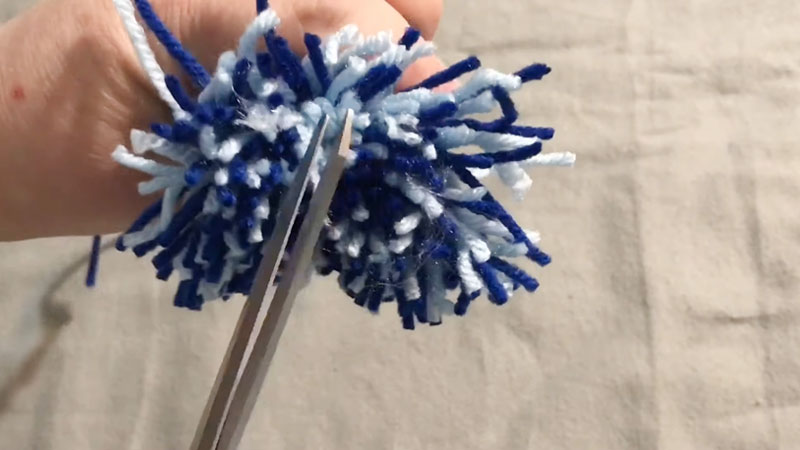
After reinforcing the knot, carefully trim any excess yarn. This enhances the appearance of the pom-pom and ensures that the knot is secure and won’t come undone. Use sharp scissors to achieve a clean and neat finish.
10. Optional: Add a Dab of Glue
If your project involves a lot of movement or if you want to add an extra layer of security, consider adding a small dab of fabric glue to the central knot.
This step is particularly useful for preventing the knot’s accidental untying or loosening.
However, exercise caution not to use too much glue, as it could affect the texture of the yarn or the appearance of the pom-pom.
Why Do Pom Poms Fall Apart?
Pom poms are delightful and colorful embellishments that add flair to various crafts, clothing, and accessories.
While they are generally fun and versatile, they can sometimes fall apart for various reasons.
Understanding these factors can help prevent and address the issue of pom poms unraveling or coming apart.
Here are the reasons why your pom poms can fall apart:
Poor Quality Materials
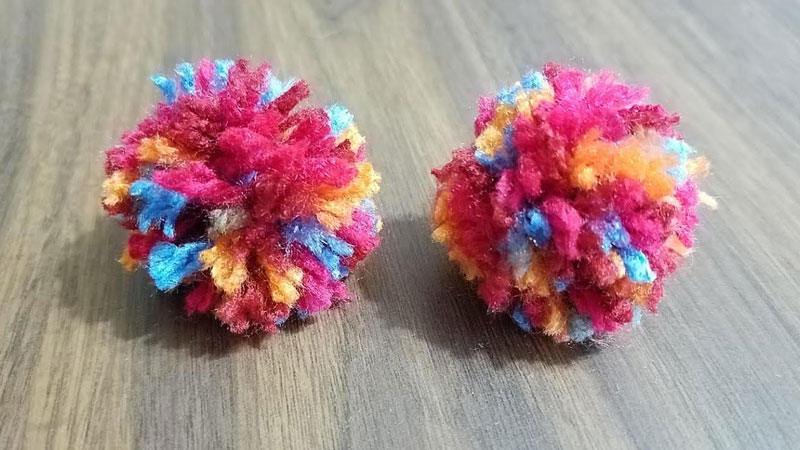
The choice of materials significantly impacts the durability of pom poms. When opting for low-quality yarn or fabric, the fibers may lack the necessary strength to withstand regular use.
Over time, the yarn may fray, resulting in the unraveling of the pom pom. Investing in higher-quality materials with strong and resilient fibers can contribute to the longevity of these charming embellishments.
Insufficient Tying
The process of tying the center knot during pom pom creation is crucial. If the knot is not tied securely, the individual loops of yarn may loosen and separate, causing the pom pom to lose its shape.
Crafters should pay careful attention to ensuring a tight and snug knot at the center to maintain the structural integrity of the pom pom.
Inadequate Trimming
After tying the center knot, meticulous trimming is essential for a neat and uniform appearance.
Uneven trimming or leaving some loops longer than others can create weak points in the pom pom.
These weak points may be more susceptible to unraveling, leading to a frayed and disheveled appearance. Precision in trimming is key to a polished and durable pom pom.
Frequent Handling
While pom poms are meant to be touched and admired, excessive handling can contribute to their premature demise.
Pulling, tugging, or frequently manipulating the pom pom can cause stress on the yarn fibers, leading to loosening and unraveling.
Treating pom poms carefully and minimizing unnecessary handling will help maintain their original charm for extended periods.
Washing and Cleaning
Pom poms attached to clothing or accessories may require washing or cleaning. However, improper care during these processes can compromise the integrity of the yarn fibers.
Harsh detergents, high-speed washing machines, or abrasive cleaning methods can weaken the fibers, making the pom pom more prone to falling apart.
Following recommended care instructions and opting for gentle handwashing can help preserve the pom pom’s structural stability.
Environmental Factors
Pom poms, like any textile, can be influenced by environmental conditions. Prolonged exposure to sunlight, high humidity, or extreme heat can accelerate the degradation of yarn fibers.
The fibers may lose their elasticity and become more susceptible to fraying and unraveling.
Storing pom-pom-adorned items in a cool, dry place and minimizing exposure to harsh environmental conditions can contribute to their overall longevity.
How to Stop POM Poms Falling Apart?
Preventing pom poms from falling apart involves taking careful steps during crafting and ensuring proper care once they are incorporated into various items.
Here’s a guide on how to keep pom poms from falling apart:
Select High-Quality Materials
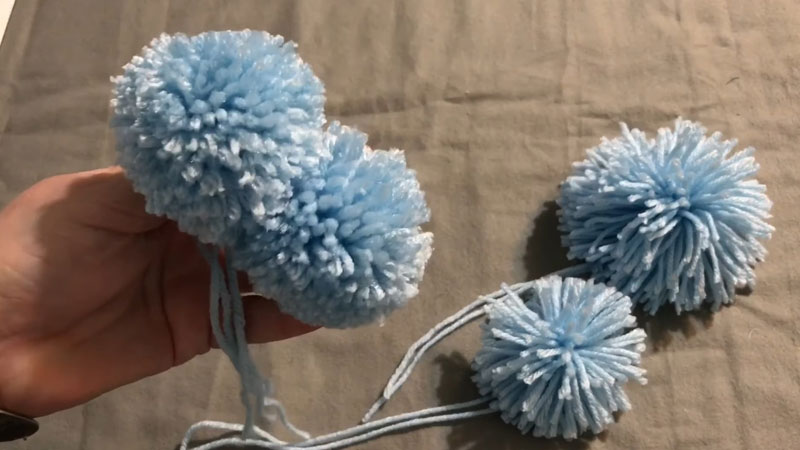
Investing in high-quality yarn or fabric is the first step in creating durable pom poms. Look for materials with strong fibers and minimal tendency to fray.
Quality materials enhance the visual appeal of the pom poms and provide a robust foundation for long-term use.
Secure and Tight Knots
The tightness and security of the central knot are pivotal in preventing pom poms from falling apart.
Take extra care when tying the knot at the center of the loops, ensuring it is snug and well-anchored.
A properly tied knot will effectively hold the individual loops together, preventing them from unraveling over time.
Precision Trimming
After tying the knot, meticulous trimming is essential for a polished appearance and structural integrity.
Even trimming ensures that all the loops are of the same length, eliminating weak points that could compromise the pom pom’s durability.
During this stage, sharp scissors and attention to detail contribute to a more resilient final product.
Limit Handling
Encourage gentle handling and minimize unnecessary manipulation of pom poms. Excessive pulling or tugging can stress the yarn fibers, making them more susceptible to unraveling.
Educate users or wearers about the delicate nature of pom poms, advising them to handle items adorned with pom poms with care.
Careful Washing and Cleaning
When pom poms are part of clothing or accessories, follow care instructions diligently. Handwashing with a mild detergent is preferable to machine washing, as it reduces the risk of damage to the yarn fibers.
By taking care during the cleaning process, you can preserve the integrity of the pom poms and the items they embellish.
Store in a Suitable Environment
The storage environment plays a crucial role in maintaining the quality of pom poms.
Store items in a cool, dry place away from direct sunlight, as exposure to environmental factors like humidity and heat can expedite the degradation of yarn fibers. Proper storage conditions contribute significantly to the longevity of pom poms.
Reinforce Weak Points
Regularly inspect pom poms for signs of wear or loose threads. If weak points are identified, reinforce them promptly by applying a small amount of clear fabric glue or stitching with matching thread.
This proactive measure can prevent potential issues from escalating and ensure the continued stability of the pom pom.
Consider Alternative Attachment Methods
Explore alternative attachment methods that provide additional stability to pom poms. Sewing them securely onto fabric or using strong adhesives can enhance their resilience.
Reinforce attachment points to reduce the risk of pom poms coming loose, especially if they are incorporated into frequently used items.
FAQs
What type of yarn is best for making pom poms that are less likely to fall apart?
Opt for high-quality yarn with strong and durable fibers to ensure the longevity of your pom poms. Avoid materials prone to fraying or breaking.
Is there a specific trimming technique to prevent weak points in the pom pom?
Meticulously trim the excess yarn to achieve even lengths for all loops. Precision trimming eliminates weak points and contributes to the structural integrity of the pom pom.
What measures can I take to minimize handling damage to the pom poms?
Encourage gentle handling and advise against excessive pulling or tugging, as these actions can stress the yarn fibers.
Minimizing unnecessary manipulation helps preserve the pom poms.
Wrap Up
Crafting durable pom poms, the journey begins with a commitment to quality materials and meticulous craftsmanship.
Choosing high-grade yarn, tying secure knots, and precision trimming creates a strong foundation.
Emphasizing gentle handling, careful washing, and suitable storage protects the pom poms from wear.
Regular inspections and reinforcing weak points with clear glue or stitching further fortify their longevity.
Exploring alternative attachment methods, like sewing or strong adhesives, adds more stability.
By integrating these practices, one can craft pom poms that dazzle with vibrant charm and stand the test of time, resilient and untarnished by the threat of unraveling.
Leave a Reply